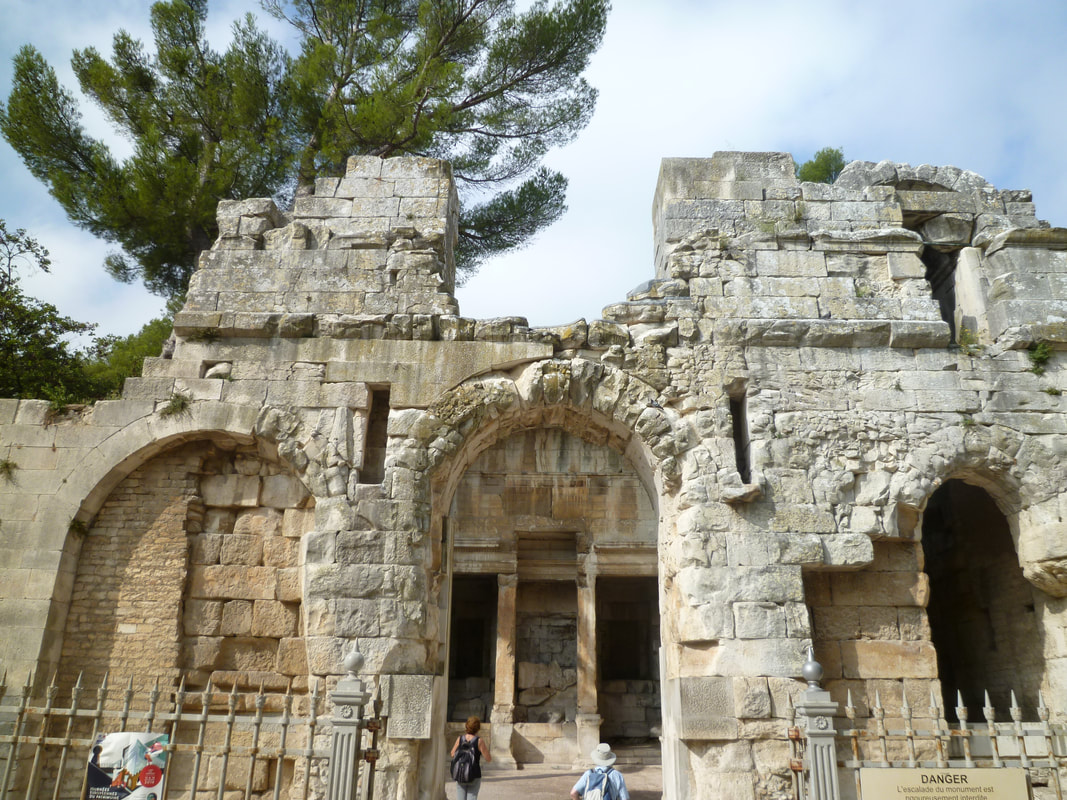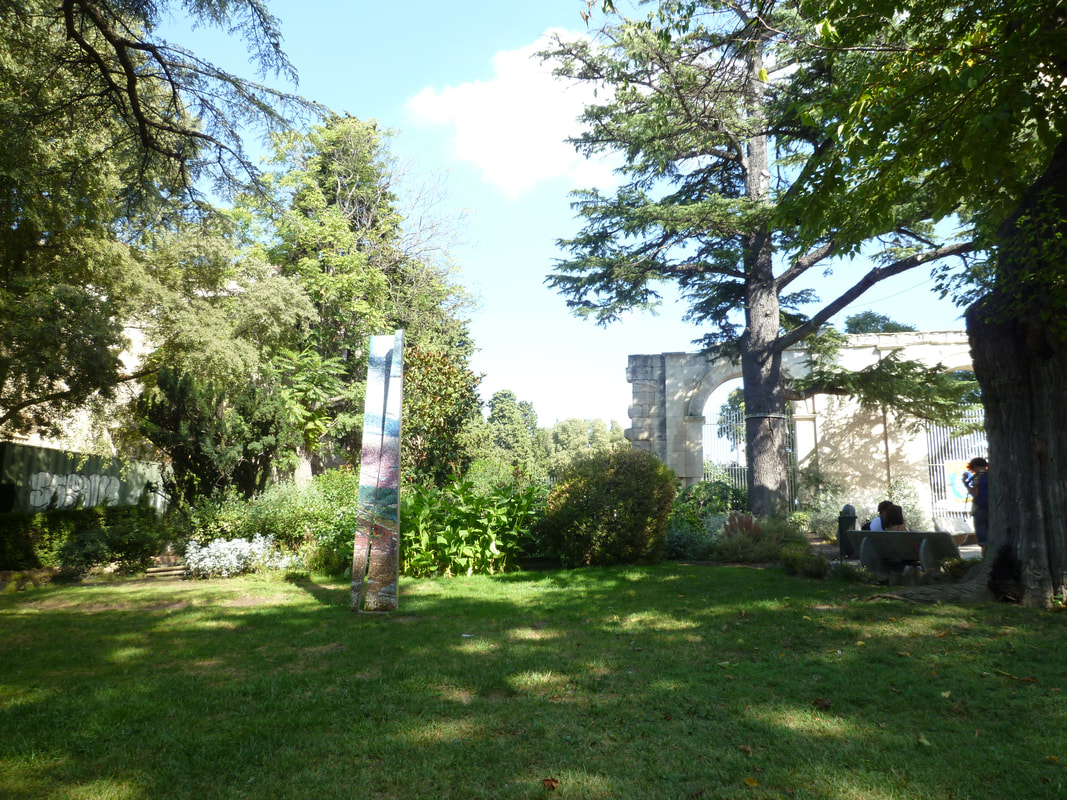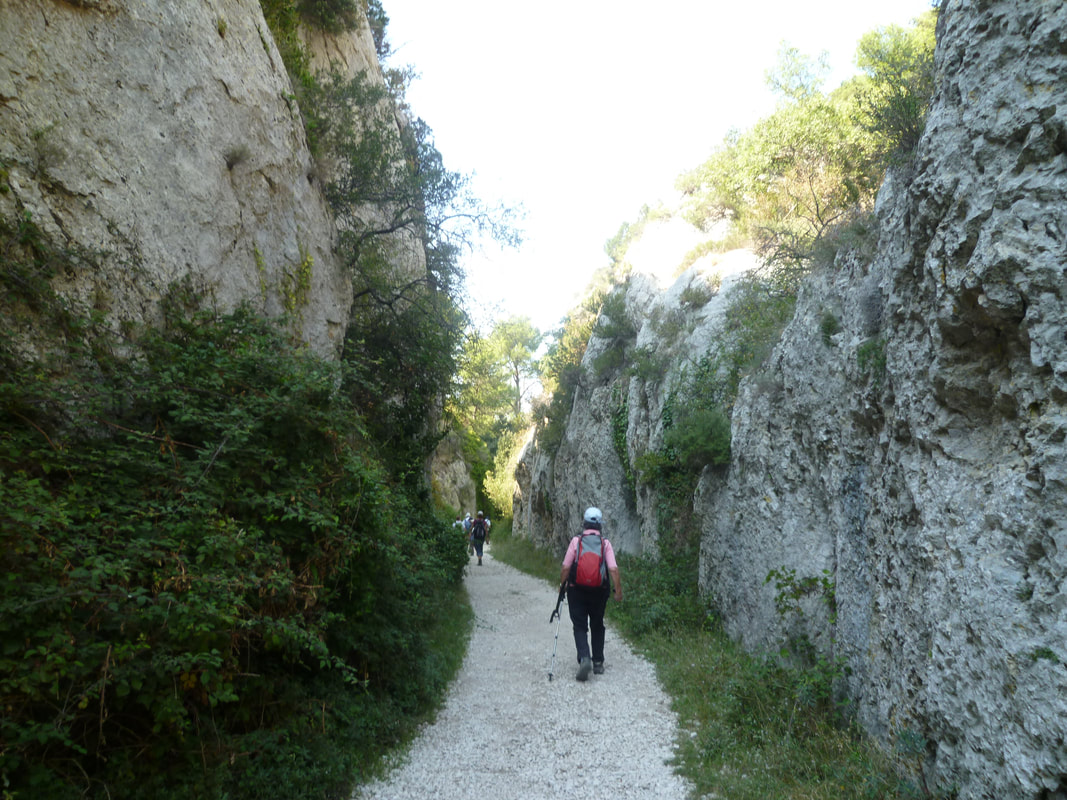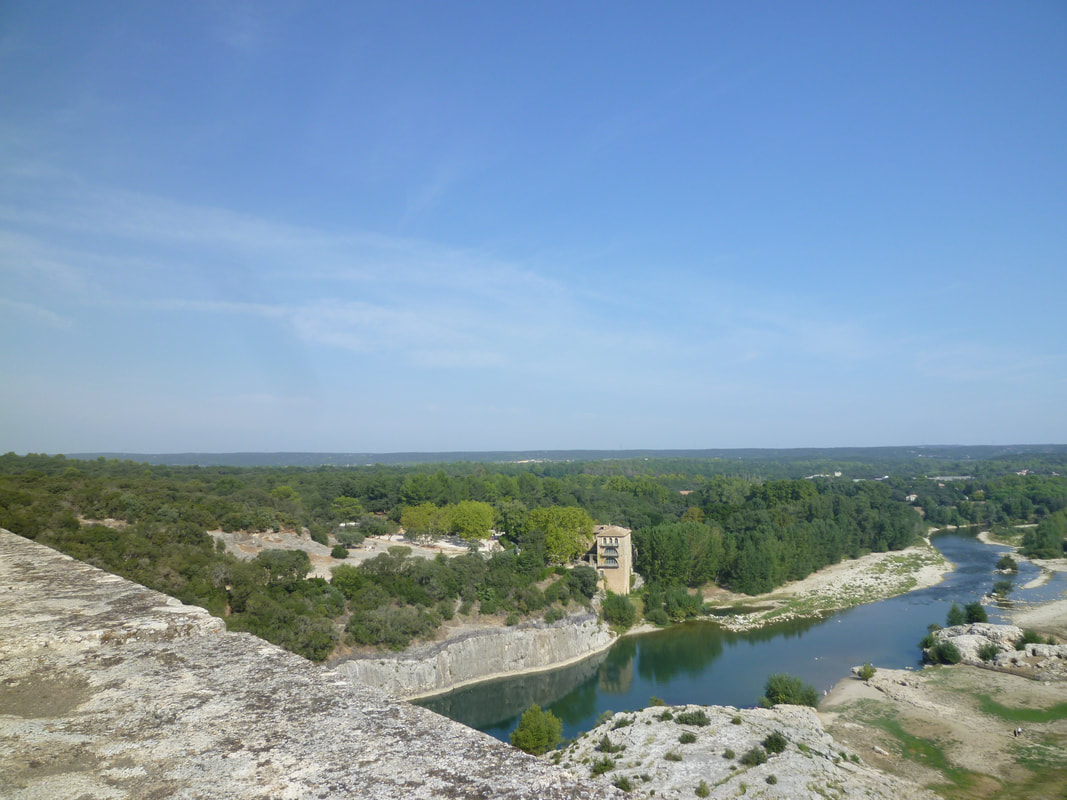Walking in France
Avignon and surrounding area
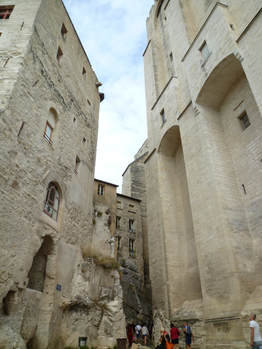 Palais des Papes
Palais des Papes
15 September 2018
Travel by train (Eurostar and TGV) to Avignon
16 September 2018
Avignon
After a good night's sleep and a simple continental breakfast in our lovely hotel located just within the well-preserved medieval city walls, it was time to explore Avignon. In the morning we walked along quaint and ancient streets, past magnificent churches and monuments, ably led by our charming local guide, Charlotte, who entertained and informed us. I've learnt so much about the local history and culture, and the quirky anecdotes made sure that the learning experience was never dull. I particularly liked the stroll along the Rue des Teinturiers, with its sculptured stone benches. As this road is quite near the hotel I will definitely walk here again. We finished the walking tour by the impressive Palais des Papes, which sits high above the River Rhone.
In the afternoon we were free to do our own thing. After relaxing over coffee with a few of my fellow travellers we split up and set off to follow our own itinerary. Today was a 'Journee Europeennes du Patrimoine', meaning that many attractions, galleries and museums could be visited for free. I decided to give the popular Palais des Papes a miss to avoid queuing and chose instead to wander around the city, have a leisurely sandwich lunch in one of the squares, explore the paintings and art objects in the Musee Angladon, and last, but not least, listen to a violin recital in the Bibliotheque Ceccano. Before the recital I had time to wander around the bibliotheque and arrived at an exhibition based on Michel Butor's poem 'Ruines d'Avenir'. It was nice sitting down and listen to the music afterwards but the music was a little obscure and I left at the interval, preferring to do some more exploring in the ancient city streets. After just one day in Avignon I feel that I already know the town quite well - didn't even need the map to find my way back to the hotel!
Travel by train (Eurostar and TGV) to Avignon
16 September 2018
Avignon
After a good night's sleep and a simple continental breakfast in our lovely hotel located just within the well-preserved medieval city walls, it was time to explore Avignon. In the morning we walked along quaint and ancient streets, past magnificent churches and monuments, ably led by our charming local guide, Charlotte, who entertained and informed us. I've learnt so much about the local history and culture, and the quirky anecdotes made sure that the learning experience was never dull. I particularly liked the stroll along the Rue des Teinturiers, with its sculptured stone benches. As this road is quite near the hotel I will definitely walk here again. We finished the walking tour by the impressive Palais des Papes, which sits high above the River Rhone.
In the afternoon we were free to do our own thing. After relaxing over coffee with a few of my fellow travellers we split up and set off to follow our own itinerary. Today was a 'Journee Europeennes du Patrimoine', meaning that many attractions, galleries and museums could be visited for free. I decided to give the popular Palais des Papes a miss to avoid queuing and chose instead to wander around the city, have a leisurely sandwich lunch in one of the squares, explore the paintings and art objects in the Musee Angladon, and last, but not least, listen to a violin recital in the Bibliotheque Ceccano. Before the recital I had time to wander around the bibliotheque and arrived at an exhibition based on Michel Butor's poem 'Ruines d'Avenir'. It was nice sitting down and listen to the music afterwards but the music was a little obscure and I left at the interval, preferring to do some more exploring in the ancient city streets. After just one day in Avignon I feel that I already know the town quite well - didn't even need the map to find my way back to the hotel!
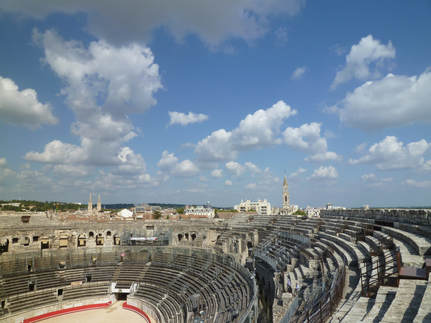 View from the top tier in the Amphitheatre
View from the top tier in the Amphitheatre
17 September 2018
Nîmes
This city is a treasure of Roman remains and architecture. Our walk started at the train station and our eyes were soon drawn to the magnificent amphitheatre. We wandered through the city centre past monuments and squares, and photographed the beautifully preserved Roman temple, the Maison Carrée. After stopping for coffee and browsing the large indoor market for something tasty for lunch, we followed the canal leading to the Jardins de la Fontaine. The garden was created in the 18th century when this ancient site was discovered. The reason why the Romans were attracted to this particular site was the natural spring, which provided water for the settlement. The formal French style garden contains many statues, interesting stone work and water features as well as the impressive Temple de Diane, another Roman monument. Having feasted our eyes on this artfully created garden we were ready for the short uphill walk leading to the Tour Magne. It is well worth climbing the steps to the top of the tower for the magnificent views across the city of Nimes and beyond. It was now time for lunch and the olive trees by the tower provided a lovely setting for a picnic.
Soon it was time to return to the old centre of Nîmes via a different route. First we found the Castellum. This is another well preserved Roman monument (the only other Castellum in similar condition is the one in Pompeii). It is a sort of water tank built into rock and from here water was transported through lead pipes to the fountains, monuments and different parts of the city. Next we stopped and admired the Porte Auguste - an entrance to the city built 16-15 b.c.
After watching an entertaining video on Nîmes' Roman history in the Maison Carrée we spent time in the Amphitheatre. I chose to follow the audioguided tour and could almost imagine myself being part of a noisy Roman crowd. From the top tier there were great views all round. This arena is incredibly well preserved and is now regularly used for events including bullfighting. That surprised me as I didn't think bullfighting was still allowed in France.
It's been an interesting day - cities are made for discovering on foot.
Nîmes
This city is a treasure of Roman remains and architecture. Our walk started at the train station and our eyes were soon drawn to the magnificent amphitheatre. We wandered through the city centre past monuments and squares, and photographed the beautifully preserved Roman temple, the Maison Carrée. After stopping for coffee and browsing the large indoor market for something tasty for lunch, we followed the canal leading to the Jardins de la Fontaine. The garden was created in the 18th century when this ancient site was discovered. The reason why the Romans were attracted to this particular site was the natural spring, which provided water for the settlement. The formal French style garden contains many statues, interesting stone work and water features as well as the impressive Temple de Diane, another Roman monument. Having feasted our eyes on this artfully created garden we were ready for the short uphill walk leading to the Tour Magne. It is well worth climbing the steps to the top of the tower for the magnificent views across the city of Nimes and beyond. It was now time for lunch and the olive trees by the tower provided a lovely setting for a picnic.
Soon it was time to return to the old centre of Nîmes via a different route. First we found the Castellum. This is another well preserved Roman monument (the only other Castellum in similar condition is the one in Pompeii). It is a sort of water tank built into rock and from here water was transported through lead pipes to the fountains, monuments and different parts of the city. Next we stopped and admired the Porte Auguste - an entrance to the city built 16-15 b.c.
After watching an entertaining video on Nîmes' Roman history in the Maison Carrée we spent time in the Amphitheatre. I chose to follow the audioguided tour and could almost imagine myself being part of a noisy Roman crowd. From the top tier there were great views all round. This arena is incredibly well preserved and is now regularly used for events including bullfighting. That surprised me as I didn't think bullfighting was still allowed in France.
It's been an interesting day - cities are made for discovering on foot.
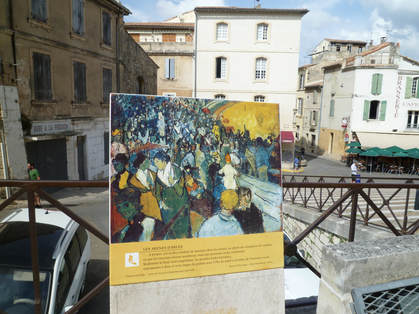 "Les Arenes d'Arles" - on the Vincent Van Gogh trail
"Les Arenes d'Arles" - on the Vincent Van Gogh trail
18 September 2018
Arles
Another day - another city to explore. Although Arles has its share of well-preserved Roman and other historic remains, most of us were more interested in walking in Vincent van Gogh's footsteps today. The artist lived and work here in 1888 and 89 and created some of his most iconic paintings during that time.
We started our walk at the train station and soon passed the amphitheatre. After collecting maps at the Tourist Information centre we started following the Vincent van Gogh trail, which connects the locations of some of his paintings. The trail took us through the Jardin d'Ete (site of the Roman theatre), past Les Alyscamps (Roman and Medieval graveyard) just outside the fortified city, and then on to the Mediatheque d'Arles - Espace Van Gogh. This building and the lovely courtyard garden still look as they did when Vincent Van Gogh painted them. I can understand why this has become a tourist hotspot. By now our walking group had shrunk considerably as we were free to chose what to see/do. One day is not nearly enough time to see all that Arles has to offer. Because of the beautiful weather I decided to continue on the Van Gogh walking trail in preference to visiting the excellent 'Vincent Van Gogh Foundation in Arles' museum. The walk continued through the Place de la Republique and on to the Place du Forum. Then it was downhill to the banks of the River Rhone. The riverside was not at all how I expected it to be - it was all concrete and bright sunshine but we did find a shady spot and a low wall to sit and eat our packed lunch. The river was strangely quiet - I would have expected more ships and boats and life! Anyway, having found another of Van Goghs painting locations (they are all indicated by a helpful panel depicting the painting and a short description) by the Pont de Trinquetaille we returned to the centre, stopping for an icecream on the way, and soaking up the atmosphere of some of the lesser trodden roads and alleys. After walking around the amphitheatre, I joined Ian and Philip on the longer route back to the train station, alongside the Rhone, to pass two more Van Gogh painting locations and we still had time for a refreshing coffee at the station before the rest of the group gradually arrived.
Arles
Another day - another city to explore. Although Arles has its share of well-preserved Roman and other historic remains, most of us were more interested in walking in Vincent van Gogh's footsteps today. The artist lived and work here in 1888 and 89 and created some of his most iconic paintings during that time.
We started our walk at the train station and soon passed the amphitheatre. After collecting maps at the Tourist Information centre we started following the Vincent van Gogh trail, which connects the locations of some of his paintings. The trail took us through the Jardin d'Ete (site of the Roman theatre), past Les Alyscamps (Roman and Medieval graveyard) just outside the fortified city, and then on to the Mediatheque d'Arles - Espace Van Gogh. This building and the lovely courtyard garden still look as they did when Vincent Van Gogh painted them. I can understand why this has become a tourist hotspot. By now our walking group had shrunk considerably as we were free to chose what to see/do. One day is not nearly enough time to see all that Arles has to offer. Because of the beautiful weather I decided to continue on the Van Gogh walking trail in preference to visiting the excellent 'Vincent Van Gogh Foundation in Arles' museum. The walk continued through the Place de la Republique and on to the Place du Forum. Then it was downhill to the banks of the River Rhone. The riverside was not at all how I expected it to be - it was all concrete and bright sunshine but we did find a shady spot and a low wall to sit and eat our packed lunch. The river was strangely quiet - I would have expected more ships and boats and life! Anyway, having found another of Van Goghs painting locations (they are all indicated by a helpful panel depicting the painting and a short description) by the Pont de Trinquetaille we returned to the centre, stopping for an icecream on the way, and soaking up the atmosphere of some of the lesser trodden roads and alleys. After walking around the amphitheatre, I joined Ian and Philip on the longer route back to the train station, alongside the Rhone, to pass two more Van Gogh painting locations and we still had time for a refreshing coffee at the station before the rest of the group gradually arrived.
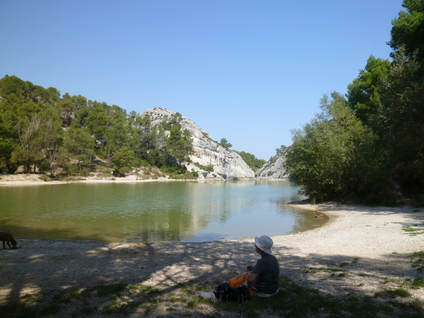 Lac des Peiroou
Lac des Peiroou
19 September 2018
Saint-Rémy-de-Provence
Today we ventured into the Provence countryside. We took the bus to Saint-Rémy-de-Provence where we had time to wander around the colourful market. I bought some fruit for lunch and some Herbes de Provence to take home. Our group then assembled by the tourist office to start the walk. First we followed another Van Gogh route, themed 'Les Paysages de Vincent van Gogh', which took us past many more locations of Vincent Van Gogh paintings, again with helpful panels. Van Gogh was inspired by the landscapes that surrounded him and some of his best loved paintings, including 'La Nuit étoilée' and 'Les iris' were created while he spent the final year of his life at the asylum St-Paul de Mausole. Part of this old monastery is now a museum devoted to Van Gogh's stay. Wandering in his footsteps felt quite moving and it is not surprising that we were part of a large number of tourists from around the world. Particularly touching was seeing the artist's sparsely furnished bedroom; but I do wish selfie sticks were banned! In fact, the crowds inside soon drove me out to the serenity of the walled garden, which is maintained today as it was in the 19th century.
After all this culture, however interesting, I was now ready for nature and a good countryside walk. First we walked along a slowly rising track that took us to a scenic reservoir, the 'Lac des Peiroou' - a picturesque location for lunch. Then we continued through pinewoods on a Randonnée in the Alpilles chain of mountains - not quite the Alps but the rocky pinnacles and variety of pine and other trees made for a scenic walk on good trails. On the way back to Saint-Rémy we looked across to the archaeological site of the Roman town of Glanum and stopped to admire 'Les Antiques' - the name given to the two well-preserved Roman monuments, the Mausoleum (30 b.c.) and the Arc de Triomphe (20 a.d.).
Arriving back in the town centre we had time for a much needed coffee and water refill before boarding the bus back to Avignon.
Saint-Rémy-de-Provence
Today we ventured into the Provence countryside. We took the bus to Saint-Rémy-de-Provence where we had time to wander around the colourful market. I bought some fruit for lunch and some Herbes de Provence to take home. Our group then assembled by the tourist office to start the walk. First we followed another Van Gogh route, themed 'Les Paysages de Vincent van Gogh', which took us past many more locations of Vincent Van Gogh paintings, again with helpful panels. Van Gogh was inspired by the landscapes that surrounded him and some of his best loved paintings, including 'La Nuit étoilée' and 'Les iris' were created while he spent the final year of his life at the asylum St-Paul de Mausole. Part of this old monastery is now a museum devoted to Van Gogh's stay. Wandering in his footsteps felt quite moving and it is not surprising that we were part of a large number of tourists from around the world. Particularly touching was seeing the artist's sparsely furnished bedroom; but I do wish selfie sticks were banned! In fact, the crowds inside soon drove me out to the serenity of the walled garden, which is maintained today as it was in the 19th century.
After all this culture, however interesting, I was now ready for nature and a good countryside walk. First we walked along a slowly rising track that took us to a scenic reservoir, the 'Lac des Peiroou' - a picturesque location for lunch. Then we continued through pinewoods on a Randonnée in the Alpilles chain of mountains - not quite the Alps but the rocky pinnacles and variety of pine and other trees made for a scenic walk on good trails. On the way back to Saint-Rémy we looked across to the archaeological site of the Roman town of Glanum and stopped to admire 'Les Antiques' - the name given to the two well-preserved Roman monuments, the Mausoleum (30 b.c.) and the Arc de Triomphe (20 a.d.).
Arriving back in the town centre we had time for a much needed coffee and water refill before boarding the bus back to Avignon.
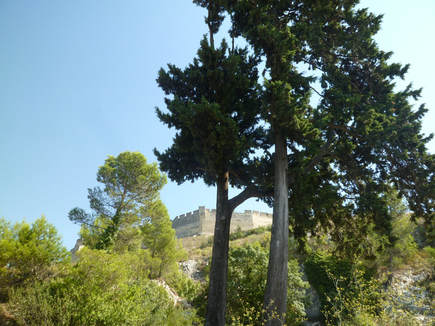 Fort Saint-André seen from the Colline des Mourgues
Fort Saint-André seen from the Colline des Mourgues
20 September 2018
Villeneuve-les-Avignons
Although in my imagination the name Villeneuve conjured up a new town, such as Milton Keynes or Bracknell, this notion was soon dispelled when I learned more about the place (no disrespect to MK or Bracknell, of course). Philippe Le Bel (King Philip IV) created the city in 1293. Before that, in the 10th century, Benedictine monks built L'Abbaye Saint-André on a hilltop. To protect the Abbey, an impressive fort was later built around it (Fort Saint-André). The town itself, just across the Rhone, has an attractive centre, boasts an excellent Museum (Musée Pierre-de-Luxembourg) and is the location of La Chartreuse du Val-de-Bénediction (Monastery founded in the 14th century), with some wonderful frescoes.
The town lies just on the other side of the Rhone, so we set off on foot from our hotel and walked across the river. The Ile de la Barthelasse stretches, as far as the eye could see, down the middle of the river and it was like crossing two rivers. We then walked, past the pretty Jardin Pompidou and the Tour Philippe Le Bel, to the tourist office to collect maps. It was our tour leaders' day off and although they were quite happy for anyone to join them today, we were of the opinion that they deserved their day of freedom!
After coffee, I set off on the walk up the hill to Fort Saint-André. I met Marilyn here and together we explored the fortress. Now Marilyn loves sketching and painting and is a lovely person but I think, like myself, she quite enjoys exploring by herself so we decided to go our separate ways for a while. First I needed to find a shady spot in the Jardins de l'Abbaye to eat my packed lunch and the Olive Grove provided that. The gardens are wonderful and I admired the views across the Rhone Valley to Avignon and distant hills. Bumped into Marilyn again and together we visited an exhibition of wonderful objects and paintings by French artist, Michel Loeb, and watched a short video of the history and restauration of the Abbey and gardens. I left Marilyn to do some more sketching and walked back to the town centre via a route that took me past the Chartreuse. Tempted though I was to explore inside, the relatively high entrance fee and lack of time, together with my need for a coffee made me decide against it! I found a quiet pavement café opposite a church. By the time I'd finished my coffee and rêverie it was time to walk back to Avignon. I chose a route that took me through the Colline de Mourgues from where I had the most fantastic views of Fort Saint-André, the Tour Philippe Le Bel and across to the Palais des Papes in Avignon. That made the extra walking effort in the heat worthwhile. I did consider taking the bus back but I had time to walk and I am, after all, on a walking holiday.
Villeneuve-les-Avignons
Although in my imagination the name Villeneuve conjured up a new town, such as Milton Keynes or Bracknell, this notion was soon dispelled when I learned more about the place (no disrespect to MK or Bracknell, of course). Philippe Le Bel (King Philip IV) created the city in 1293. Before that, in the 10th century, Benedictine monks built L'Abbaye Saint-André on a hilltop. To protect the Abbey, an impressive fort was later built around it (Fort Saint-André). The town itself, just across the Rhone, has an attractive centre, boasts an excellent Museum (Musée Pierre-de-Luxembourg) and is the location of La Chartreuse du Val-de-Bénediction (Monastery founded in the 14th century), with some wonderful frescoes.
The town lies just on the other side of the Rhone, so we set off on foot from our hotel and walked across the river. The Ile de la Barthelasse stretches, as far as the eye could see, down the middle of the river and it was like crossing two rivers. We then walked, past the pretty Jardin Pompidou and the Tour Philippe Le Bel, to the tourist office to collect maps. It was our tour leaders' day off and although they were quite happy for anyone to join them today, we were of the opinion that they deserved their day of freedom!
After coffee, I set off on the walk up the hill to Fort Saint-André. I met Marilyn here and together we explored the fortress. Now Marilyn loves sketching and painting and is a lovely person but I think, like myself, she quite enjoys exploring by herself so we decided to go our separate ways for a while. First I needed to find a shady spot in the Jardins de l'Abbaye to eat my packed lunch and the Olive Grove provided that. The gardens are wonderful and I admired the views across the Rhone Valley to Avignon and distant hills. Bumped into Marilyn again and together we visited an exhibition of wonderful objects and paintings by French artist, Michel Loeb, and watched a short video of the history and restauration of the Abbey and gardens. I left Marilyn to do some more sketching and walked back to the town centre via a route that took me past the Chartreuse. Tempted though I was to explore inside, the relatively high entrance fee and lack of time, together with my need for a coffee made me decide against it! I found a quiet pavement café opposite a church. By the time I'd finished my coffee and rêverie it was time to walk back to Avignon. I chose a route that took me through the Colline de Mourgues from where I had the most fantastic views of Fort Saint-André, the Tour Philippe Le Bel and across to the Palais des Papes in Avignon. That made the extra walking effort in the heat worthwhile. I did consider taking the bus back but I had time to walk and I am, after all, on a walking holiday.
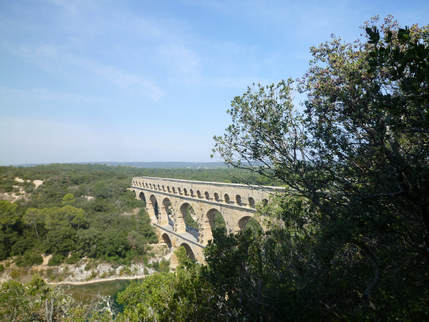 Le Pont du Gard
Le Pont du Gard
21 September 2018
Le Pont du Gard
Today we set off in the early morning mist for the trip to the UNESCO World Heritage Site, the magnificent Pont du Gard aqueduct. The sun soon burnt through the mist and it promised to be another beautiful day. First we walked through the charming village of Vers-Pont-du-Gard. Many of us couldn't resist the culinary delights of the boulangerie. The walk between the village and the Pont du Gard Visitor Centre was rather disappointing as we had to walk along roadside verges. However, that was soon forgotten when we arrived at what what would be one of the highlights of the holiday. We had the option of joining a guided tour which included a walk on the top tier of the aqueduct. As the top tier was not accessible to individuals, I decided to join the tour. This proved to be very interesting and as the commentary was in both French and English I may well have improved my understanding of the French language. I will not go too deeply into the history and technical wonder of the building of the bridge as there is plenty of information available on the net. In short, the Romans built the aqueduct as part of an integrated system to carry water from a natural spring near Uzes to Nîmes.
I would like to mention that the modern Visitor Centre which includes a museum, shop and restaurant was cleverly built a short walk away from the aqueduct. The bridge is not visible from the centre and equally the centre is not visible from the bridge (not even from the very top of the bridge). In fact, the area around the bridge is completely unspoilt.
After walking across the mostly enclosed and slightly claustrophobic top of the bridge a few of us walked across to a viewpoint and enjoyed our picnic lunch while having the most amazing view of the Pont du Gard. I then walked back along the second tier open walkway and returned to the visitor centre for a brief visit to the museum - mainly to cool down in the airconditioned building! Soon it was time to head across the bridge again to meet up with the rest of the group. We now walked through an arid and scrubby landscape on a plateau above the Gard valley. Only on closer inspection did the vegetation reveal itself as varied and interesting and the butterflies and crickets certainly enjoyed the hot weather. As for the rest of us, I think we were all glad when the path descended into valley and we reached the town of Remoulins, which is located further down the River Gard from the aqueduct. After a rehydrating drink and a reviving coffee we had a little bit of time to explore the old centre of the town before meeting up at the bus stop for the ride back to Avignon. It's been an amazing day but almost too hot for walking.
22 September 2018
Return by train (TGV and Eurostar) to St Pancras
Return by train (TGV and Eurostar) to St Pancras
